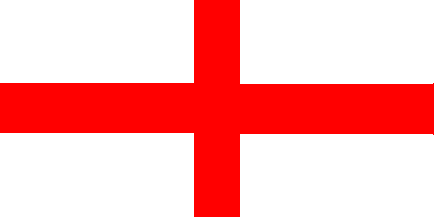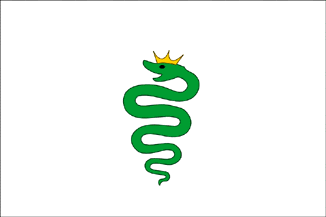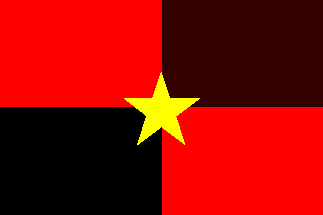 image by Andre' Serranho
image by Andre' Serranho
Last modified: 2021-08-24 by rob raeside
Keywords: italy | lombardy | visconti | serpent | lombardia | milan | cross: saint george | viper | snake | crown |
Links: FOTW homepage |
search |
disclaimer and copyright |
write us |
mirrors
See also:
Other sites:
About the origin of the white flag with the red cross, some
authors state that in the year 930 the town got the citizenship
of Milan, receiving the standard from the archibishop of Milan,
Lambert. The use of the cross dates back to the X century, well
before the crusades. On the other hand, in 1113 the flag is shown
as the "Admiral flag" and when in 1138 the town
obtained from the Emperor to mint coins, they presented a cross
on a side and a Griphon on the other. This last was the elder
symbol of the Comune and going to last for a long time.
Pier Paolo Lugli, 28 December 1997
While being at Milan-Malpensa airport, I noticed
that in the Milanese flag
hoisted outside the termonal, there is a viper at the canton. It
is the same viper as appear on Visconti flag below.
Dov Gutterman, 26 October 2004
This flag with red cross is in fact the flag of St. Ambrose
(Bishop of Milan from 374 to 397). St. Ambrose is the city patron
and also the saint whome the Milan Cathedral (3rd largest church
in the world) is dedicated to. For more information, read the
story about the battle of legnano (suburb of milan) and
especially the part about the Carroccio. St. Ambrose was
also the Bishop who had the most influence on northern italy.
Alex D. Friedrich, 6 November 2005

image by Jaume Ollé, 25 October 1998
Visconti flag 1277-1397. Reconstructed from writen
descriptions. In 1397 the use of imperial eagle was granted by
Empeor. Seems that a flag with three eagles was used until 1537
when Aragon and Castilla King took the country. From the Austria
dinasty the country was in heir to Austria but was occuped
temporary by French. Under Austria a King named "Lombardo
veneto" was created. Their attribued flag was already
posted, but is doubteful. Milan used also the white flag with red
saint george cross.
Jaume Ollé, 25 October 1998
Jaume Olle said: "Visconti flag 1277-1397. Reconstructed
from writen descriptions. In 1397 the use of imperial eagle was
granted by Empeor". However in Padanian
Flag of Insubria page, Gallinelli said: "It was granted
by the emperor Wenceslaw in 1395 to Gian Galeazzo Visconti first
duke of Milan, being the dukedom part of the Holy Roman Empire.
That is why the black eagle appears in the first and fourth
quarter" In conclusion Jaume's image is, chronologically,
the first flag of the Dukedom; and the image at Insubria's page
was the evolution after 1395 of the previous flag . So it seems
that the Padanian Flag of Insubria should be considered as a
political flag in its modern use (autonomist of Insubria), but it
is also an historical flag of Milano and Western Lombardy.
Matteo Colaone, 11 November 2000
From 1395 onwards the Visconti family became Duke of Milan and
added the imperial arms to their standard. An interesting
document reports about the title grantin. The Chronicle of
Bernardino Corio, laid down a few years after the event, says
that Benesio, Lieutnant of the Empero Wenceslaw, lead the
cerimony. An Alaman knight bore the Imperial standard on the
right of the future Duke and Ottone Mandello, a knight, bore the
standard of the viper, symbol of the Visconti family, quartered
with the imperial eagle.
A miniature by Anovelo da Imbonate shows the two standards square
in shape.
On the burial monument of Gian Galeazzo Visconti, the cerimony is
simplified and only the family banner flies: the viper is on a
swallow tailed flag.
Source: I 600 anni del Ducato di Milano (600 years of
the Dukedom of Milan), D. Pozzagalli, Milano 1996.
Pier Paolo Lugli, 11 June 2001
The flag above for Milan Dukedom is not correct. The snake has to be blue and eating a child. Here is a short history of Visconti coats of arms:
La vipera che il Milanese accampa...
The Viper marshalling the Milanese…
(Dante, La Divina Commedia, Purgatorio, Canto VIII)
The Biscione (grass snake), symbol of Visconti family (and then of other Milan prides such Alfa Romeo or Inter Football Club) comes from Longobard totem: the blue drake meaning power, loyalty, surveillance and the man in its jaws represents Visconti’s enemies that the snake is always ready to destroy.
There are some traditions on the origins of Visconti insignia: one says that Ottone Visconti, the founder of the family, at the first Crusade killed a Saracen warrior and so took his arms which had drawn on a snake eating a man. An other reports that in the lake Gerundo, near Milan, now disappeared, lived the drake Tarantasio, an enormous snake that ate children and with its venomous breath polluted the water and made men ill; Ottone Visconti killed the drake and took as his coats of arms the snake eating the child.
When Gian Galeazzo Visconti in 1395 became
the first Duke of Milan, he added the Imperial Eagle on his arms,
quartering it with the Biscione.
Claudio Torrisi, 7 April 2006

image by Ivan Sache, 26 May 2005
There was some vexillological confusion during the uncredible
final of the Champions' League yesterday (25 May 2005) evening.
At first and partial sight, the match played in Istanbul Olympic
Stadium was Austria vs. England. There was indeed an
"Austrian" flag in the Kop (supporters) of Liverpool,
whereas the tifosi from Milan used a St. George's cross flag. Of
course, the first flag represented FC Liverpool whereas the St.
George's cross is also the flag of the city of Milan (said to be
older than the Crusades and therefore predating the English flag,
shocking!). Among the several flags used by the
supporters, I noticed a Milanese flag of particular interest. The
flag is quartered red and black with a yellow star in the middle.
Red and black are the traditional colours of Milan AC (the
players must be nicknamed rossi-neri or something like this). The
yellow star, also shown on the players' jersey over the club
shield, The star must recall that Milan AC won once the
Champions' League (in fact, they won the Cup five times, but four
times before the 1997 reform, which changed the system and the
name of the cup from Champions Clubs' Cup to Champions' League).
Ivan Sache, 26 May 2005
In fact, the yellow star is awarded to the winners of 10
national Italian titles. Thus Juventus have two stars, Inter and
Milan have one and so on...
Fabrizio Ridolfi, 23 June 2005
The yellow star on the football team flag
doesn't indicates the victory in champions league. In Italy,
we use to put a yellow star up the shield of the team every
10 national championship won. Milan and Inter has 1 star becouse
they have won more than 10 championship while only juventus has 2
stars, becouse has won 28 championships.
Raffaele Giovanni Pellegrino, 23 June 2005

image by Ivan Sarajcic, 22 June 2007
The flag that AC Milan's footballer Inzaghi carried after the
final Champions League game 2007, according to photo at <www.viewimages.com>.
The flag is 12X8 chequered red and black flag, with column to
hoist and to fly slightly cropped.
Ivan Sarajcic, 22 June 2007